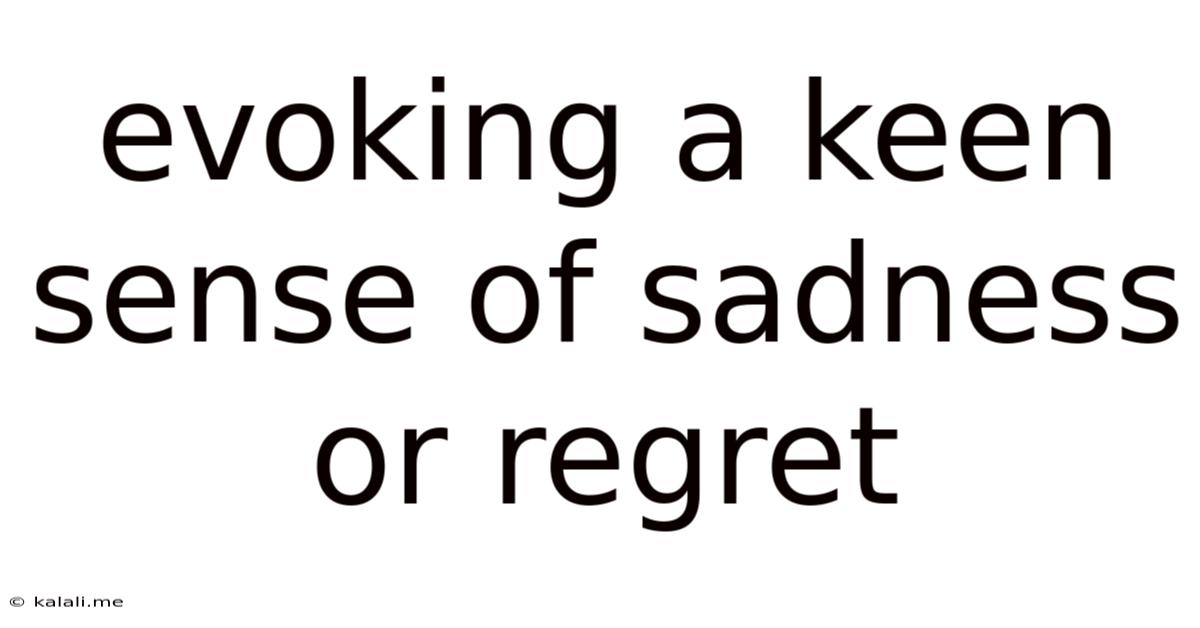Evoking A Keen Sense Of Sadness Or Regret
Kalali
Jun 11, 2025 · 3 min read

Table of Contents
Evoking a Keen Sense of Sadness or Regret: Mastering the Art of Melancholy in Your Writing
This article explores the techniques writers can use to evoke a profound sense of sadness or regret in their readers, transforming a simple narrative into a deeply emotional experience. Mastering this skill can significantly enhance the impact and memorability of your work, whether it's fiction, poetry, or even non-fiction storytelling. We'll delve into the specific tools and strategies that can help you paint vivid pictures of melancholy and loss, resonating deeply with your audience.
Understanding the Power of Melancholy
Sadness and regret are powerful emotions. When skillfully evoked in writing, they can create a connection with the reader on a visceral level. They can make a story more relatable, memorable, and ultimately, more impactful. The key is not to simply state sadness, but to show it through carefully chosen words, imagery, and narrative techniques. Think of it as painting a picture of melancholy, rather than simply describing the color "blue."
Techniques for Evoking Sadness and Regret
Several techniques can be employed to successfully evoke these emotions:
1. Sensory Details: Engage the reader's senses. Instead of saying "she was sad," describe the heavy weight in her chest, the dampness in her eyes, the tremor in her voice, or the chilling emptiness of the room. Use descriptive language that paints a picture of desolation and despair. Consider the sounds of silence, the taste of bitter coffee, or the smell of rain on dry earth – all can contribute to the overall feeling of melancholy.
2. Memory and Nostalgia: Tap into the power of memory. Describe a cherished moment from the past, now tainted by regret or loss. Contrast the vibrant hues of the past with the muted tones of the present. This juxtaposition amplifies the sense of longing and sadness. Think of a faded photograph, a half-forgotten melody, or a familiar scent that triggers a flood of bittersweet memories.
3. Internal Monologue and Stream of Consciousness: Give the reader access to the character's inner thoughts and feelings. Allow them to experience the raw emotion through introspection and self-reflection. This intimate perspective allows for a deeper understanding of the character's sadness and regret, fostering empathy in the reader.
4. Symbolism and Metaphor: Employ evocative imagery and symbolism to represent the emotional state of your characters. A wilting flower, a broken mirror, or a deserted landscape can all serve as powerful metaphors for loss and despair. These symbolic elements add layers of meaning to the narrative, enriching the reader’s emotional experience.
5. Pacing and Structure: Control the pace of your writing to heighten the emotional impact. A slow, deliberate pace can amplify feelings of sadness and reflection, while sudden shifts in pace can represent the unexpected nature of grief or regret. Consider the use of short, fragmented sentences to convey a sense of disorientation or emotional overwhelm.
6. Character Relationships and Loss: Explore the impact of loss on relationships. The death of a loved one, a broken friendship, or a missed opportunity can all lead to profound sadness and regret. Show how these losses affect the character's interactions with others and their overall perspective on life.
7. Setting and Atmosphere: The environment plays a crucial role in setting the mood. A gloomy, rain-soaked city, a desolate landscape, or a dimly lit room can all contribute to a feeling of sadness and loneliness. Use vivid descriptions to immerse the reader in the atmosphere of melancholy.
Subtlety is Key
While powerful imagery is important, avoid melodrama. Subtlety is key to creating a truly resonant experience. Allow the reader to infer the depth of emotion through implication rather than explicit statement. The most impactful sadness is often felt implicitly, leaving a lasting impression long after the story has ended.
By mastering these techniques and understanding the nuances of human emotion, you can create writing that not only informs but also profoundly moves your readers, leaving them with a lingering sense of sadness and regret – a testament to your storytelling prowess.
Latest Posts
Latest Posts
-
How Much Is A Quarter Million Dollars
Jul 01, 2025
-
How Many Laps Around A Basketball Court Is A Mile
Jul 01, 2025
-
How Much Does A Sandwich Bag Weigh
Jul 01, 2025
-
I Wanna Go Where The Thunder Dont Roar Lyrics
Jul 01, 2025
-
One Onion Equals How Much Onion Powder
Jul 01, 2025
Related Post
Thank you for visiting our website which covers about Evoking A Keen Sense Of Sadness Or Regret . We hope the information provided has been useful to you. Feel free to contact us if you have any questions or need further assistance. See you next time and don't miss to bookmark.